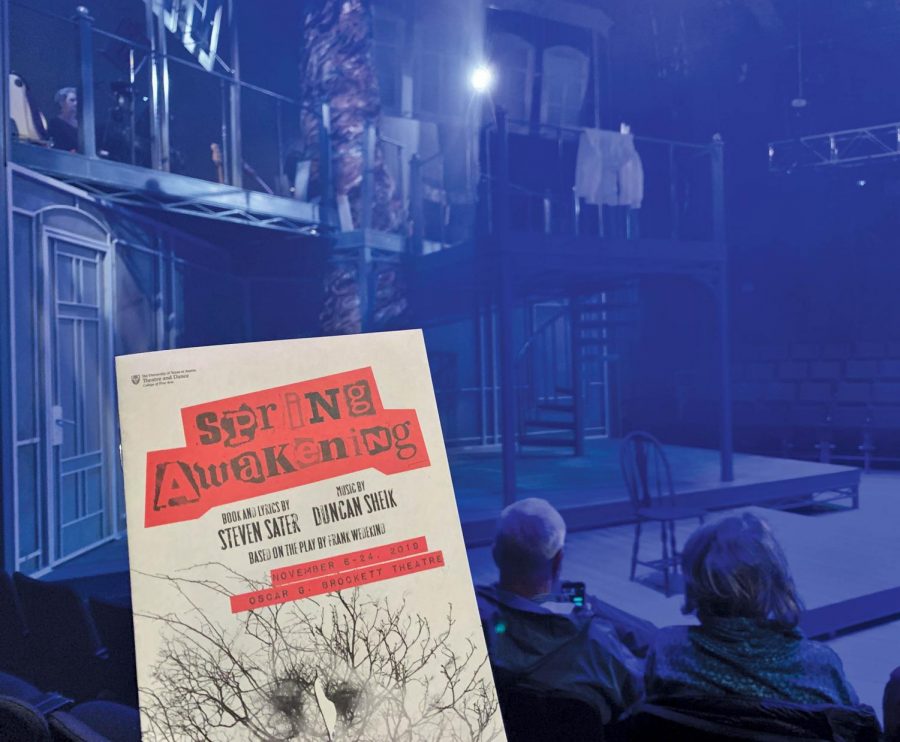Missed ‘Spring Awakening’? Check out UT’s modern interpretation
Isabela Spielman / Hilltop Views
‘Spring Awakening’ runs until Nov. 24 at the Oscar G. Brockett Theatre on UT’s campus. Tickets can be found at: theatredance.utexas.edu
If you missed “Spring Awakening” this past spring at the Mary Moody Northen Theatre, or if you simply can’t get enough of this Tony Award-winning show, make your way up north to the University of Texas to see it. With direction by UT MFA candidate Anna Skidis Vargas, this show by Steven Sater and Duncan Sheik is nothing short of wonderful.
Vargas’ take on the show has a more modern eye compared to St. Edwards’ production, exemplified in projections designed by MFA candidate Logan Smith. As actors break into song and dance, audiences can catch flashes of Latin, sailboats and even some crude drawings on the back facade. While most of these projections add to the storytelling by offering some insight into a character’s thoughts or illustrating a metaphor, some feel over-the-top and excessive.
The set design by MFA candidate Tucker Goodman, is also noteworthy for its beauty in simplicity. It depicts the inside of a building with a thin spiral staircase leading up to a small landing, with the occasional desk, chair or piano wheeled out by actors.
At the center, a large tree bursts through the stage, breaking up the uniformity and rigidity of the set and alluding to the journey the characters take throughout the show.
Speaking of the characters, this all-student cast attacks them with enthusiasm. “Spring Awakening” follows the growing sexuality of young teens in late 19th century Germany, and the suppression of that by their parents and teachers. Savannah Cole and Jeremiah Abdulla as Wendla and Melchior, respectively, lead the cast maturely, especially during the climax of the first act. Audiences may find it shocking to see an explicit sexual act simulated right on stage, but the pair handles the scene with grace.
The definitive stars of the show, however, are Lea Donnenberg as Ilse and Pedro Antonio Castañeda as Moritz. Donnenberg’s control of the stage is incredible. In group scenes, I often found myself watching her over the other actors purely due to her incredible characterization of Ilse. Castañeda shines in his role, depicting Moritz’s descent into depression with heart-wrenching truth. While at times I didn’t believe the characterizations of the other leads, Castañeda gave a consistent performance throughout the show, making Moritz’s eventual death and funeral that much harder to watch.
Overall, the vocal performances from the cast were skillful and pretty. However, the aesthetic appeal didn’t always fit the emotional journey of the song, distancing the audience from the truth of the story.
Also notable are Juleeane Villarreal and Ryan Alvarado portraying the various adults in the production. Both actors had several roles to play, juggling costumes and props throughout the show. Those unfamiliar with the show prior to seeing this production need to be extra vigilant for costume changes the pair make.
This is a heavy show. If you are sensitive to subjects such as physical and sexual abuse, depression and suicide, prepare yourself before going into this show. But also know that this show is filled with laughter and hope, and that the students do a fantastic job telling this story. You don’t want to miss this incredible take on this heartbreaking story.







